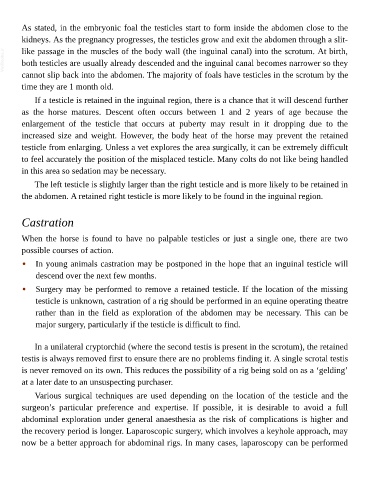Page 917 - The Veterinary Care of the Horse
P. 917
As stated, in the embryonic foal the testicles start to form inside the abdomen close to the
kidneys. As the pregnancy progresses, the testicles grow and exit the abdomen through a slit-
VetBooks.ir like passage in the muscles of the body wall (the inguinal canal) into the scrotum. At birth,
both testicles are usually already descended and the inguinal canal becomes narrower so they
cannot slip back into the abdomen. The majority of foals have testicles in the scrotum by the
time they are 1 month old.
If a testicle is retained in the inguinal region, there is a chance that it will descend further
as the horse matures. Descent often occurs between 1 and 2 years of age because the
enlargement of the testicle that occurs at puberty may result in it dropping due to the
increased size and weight. However, the body heat of the horse may prevent the retained
testicle from enlarging. Unless a vet explores the area surgically, it can be extremely difficult
to feel accurately the position of the misplaced testicle. Many colts do not like being handled
in this area so sedation may be necessary.
The left testicle is slightly larger than the right testicle and is more likely to be retained in
the abdomen. A retained right testicle is more likely to be found in the inguinal region.
Castration
When the horse is found to have no palpable testicles or just a single one, there are two
possible courses of action.
• In young animals castration may be postponed in the hope that an inguinal testicle will
descend over the next few months.
• Surgery may be performed to remove a retained testicle. If the location of the missing
testicle is unknown, castration of a rig should be performed in an equine operating theatre
rather than in the field as exploration of the abdomen may be necessary. This can be
major surgery, particularly if the testicle is difficult to find.
In a unilateral cryptorchid (where the second testis is present in the scrotum), the retained
testis is always removed first to ensure there are no problems finding it. A single scrotal testis
is never removed on its own. This reduces the possibility of a rig being sold on as a ‘gelding’
at a later date to an unsuspecting purchaser.
Various surgical techniques are used depending on the location of the testicle and the
surgeon’s particular preference and expertise. If possible, it is desirable to avoid a full
abdominal exploration under general anaesthesia as the risk of complications is higher and
the recovery period is longer. Laparoscopic surgery, which involves a keyhole approach, may
now be a better approach for abdominal rigs. In many cases, laparoscopy can be performed

